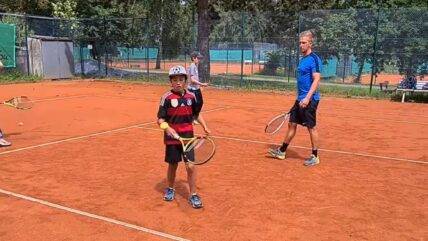Today I would like to talk a little bit about tennis training on clay. In Germany, the clay court season is just around the corner and the first courts have already opened. At this time, I often ask myself the question:
Which drills should I do with my students when they play outside on clay for the first time?
Personally, I find the transition from hard court to clay, or from indoor to outdoor in general, much more difficult than having to adjust from outdoor to indoor (clay court to carpet or hard court).
So how can you get back to your game on clay as quickly as possible? Here are my 5 tips for the first training sessions on clay:
Tip 1: Hit balls, hit balls and hit balls again!
Make the repetition of strokes the most important topic in your first training sessions. I do almost exclusively rhythm drills with my students. Probably the best known is the suspenders drill, which I have already shown dozens of times in my videos. With this drill, or with similar drills, you achieve a frequent repetition of the basic strokes. It creates a rhythm and there is also already a focus on footwork. Another perfect suggestion for the start on clay is my video “31 Baseline Warm Up Drills“. Check it out. I also recommend the trainer’s classic feeding drills from the baseline. Here, you can hit many strokes in a row, which makes it easier to get used to clay.
Tip 2: Footwork is the key to success
I don’t need to tell you that footwork is an important part of tennis. But on clay, footwork is even more important. The rallys on clay are usually longer, so the most important thing here is good recovery. It’s best to incorporate footwork drills into your tennis training right from the start. Overcross, sidestep, splitstep are the be-all and end-all and should not be lest out. It is also possible to slide on clay. You should also include this in your training if your tennis court is firm enough (never slide on courts that are too soft = risk of injury). Sliding on clay is not only fun, it also has a very clear purpose. By sliding, I manage to push my body’s center of gravity towards the ground and get closer to the ball at the same time. This makes your strokes more explosive and economical.
Tip 3: Set the focus on topspin and slice
Topspin is much more effective on clay than on carpet, for example. The surface is harder and the sand takes the spin much better, therefore you can play higher over the net with even higher stroke speeds. For example, try stretching a rope above the net and get used to hitting the ball higher over the net. In my video “Drills with higher net” on YouTube, I have put together some drills for you. But also the slice is very effective on sand. It bounces much flatter and makes your opponent have to go deeper into his knees. The slice is also extremely effective as a tactical stroke, e.g. to vary the speed of play.
Tip 4: Learn to be patient
Especially very offensive players definitely have to adjust on clay. I am one of them. I like to play very offensively, prefer to win points quickly and hit powerful shots. I have to change that on clay, because the opponent will reach my balls much more often. In case of doubt, the safer game usually wins. Therefore, try to include tactical drills in your practice session. Also offensive players have to learn to build up the point and to play patiently. The right time is often decisive for winning the point, i.e.: When do I go for the winning shot and when not?
Tip 5: Work on positioning
I mentioned it at the beginning: Recovering with footwork is very important. But where do I have to move on clay? Here you should pay particular attention to movement to the angle bisector in your drills. A good court coverage is extremely important on clay, because especially angled balls can be extremely effective. Feeding drills, for example, can be used here, in which the trainer places particular emphasis on positioning.
By the way: I neglect serve and return in the first 2-3 training sessions. I put the main focus on the groundstrokes. Often, strokes like serve and return become much easier for the students in the following lessons. The situation is different, of course, when the first tournaments are coming up. Here I have to incorporate these strokes into my training.
I hope my tips helped you and you had a good first training session on clay. Enjoy the outdoor season and have fun practicing!










